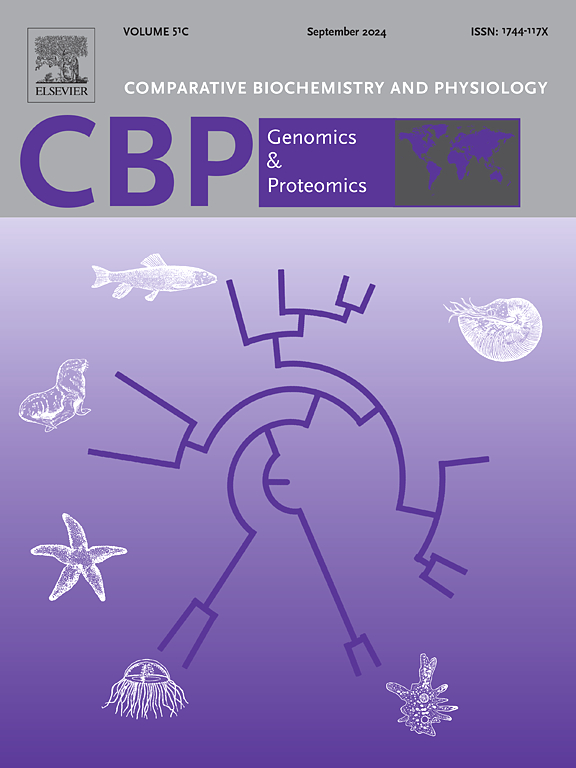Liver transcriptome analysis reveals genes and pathways involved in the ovarian development in spotted scat (Scatophagus argus)
IF 2.2
2区 生物学
Q4 BIOCHEMISTRY & MOLECULAR BIOLOGY
Comparative Biochemistry and Physiology D-Genomics & Proteomics
Pub Date : 2025-05-30
DOI:10.1016/j.cbd.2025.101550
引用次数: 0
Abstract
Scatophagus argus is a highly valuable aquaculture fish. Its artificial breeding faces problems in the induction of high quality eggs, thus necessitating studies on the regulation of ovarian development. As the centre of nutrient metabolism in fish, the liver provides the material basis for ovarian development. However, the molecular mechanism of the liver in ovarian development in S. argus is still unclear. In this study, a transcriptome analysis of adult S. argus livers at different stages of ovarian development (stages II, III and IV) was performed. 410, 1025 and 1867 differentially expressed genes (DEGs) were obtained between stages II and III, stages II and IV and stages III and IV, respectively. In GO and KEGG analyses, DEGs were mostly involved in vitellogenesis and egg envelope formation (e.g., erα, erβ1, vtga, vtgb, vtgc, zp3, zp4a and zp4b), lipid metabolism and energy metabolism (e.g., dagt1, dagt2, lpl, apob, hk1, acly, ogdh, pc, and fbp1), and hormone signaling (e.g., lepa and igfbp1). Additionally, genes that were significantly upregulated in the liver at stage IV of ovarian development, compared to stages II and III, were markedly enriched in steroid biosynthesis and metabolism pathways. These findings provide clues to understanding the mechanisms of liver action in teleost ovarian development.

肝转录组分析揭示斑点鱼卵巢发育的相关基因和途径
泥鳅是一种非常有价值的水产养殖鱼类。其人工育种在诱导高质量卵子方面存在问题,因此需要对卵巢发育的调控进行研究。肝脏作为鱼类营养物质代谢的中心,为卵巢发育提供物质基础。然而,肝脏在银螺卵巢发育中的分子机制尚不清楚。在这项研究中,对卵巢发育不同阶段(II、III和IV期)的成年银鳗肝脏进行了转录组分析。在II期和III期、II期和IV期、III期和IV期分别获得410、1025和1867个差异表达基因(deg)。在GO和KEGG分析中,DEGs主要参与卵黄发生和卵包膜形成(如erα、erβ1、vtga、vtgb、vtgc、zp3、zp4a和zp4b)、脂质代谢和能量代谢(如dagt1、dagt2、lpl、apob、hk1、acly、ogdh、pc和fbp1)以及激素信号传导(如lepa和igfbp1)。此外,与卵巢发育II和III期相比,卵巢发育IV期肝脏中显著上调的基因在类固醇生物合成和代谢途径中显著富集。这些发现为理解肝在硬骨鱼卵巢发育中的作用机制提供了线索。
本文章由计算机程序翻译,如有差异,请以英文原文为准。
求助全文
约1分钟内获得全文
求助全文
来源期刊
CiteScore
5.10
自引率
3.30%
发文量
69
审稿时长
33 days
期刊介绍:
Comparative Biochemistry & Physiology (CBP) publishes papers in comparative, environmental and evolutionary physiology.
Part D: Genomics and Proteomics (CBPD), focuses on “omics” approaches to physiology, including comparative and functional genomics, metagenomics, transcriptomics, proteomics, metabolomics, and lipidomics. Most studies employ “omics” and/or system biology to test specific hypotheses about molecular and biochemical mechanisms underlying physiological responses to the environment. We encourage papers that address fundamental questions in comparative physiology and biochemistry rather than studies with a focus that is purely technical, methodological or descriptive in nature.

 求助内容:
求助内容: 应助结果提醒方式:
应助结果提醒方式:


